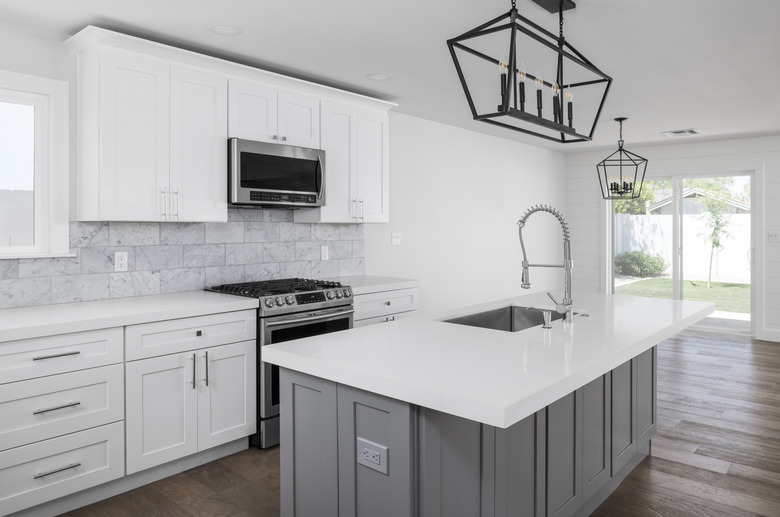How To Remove A Granite Backsplash From A Wall
We may receive a commission on purchases made from links.
Granite is an elegant backsplash material, but it's possible to get tired of elegance, especially if you've got your heart set on another kitchen aesthetic in mind. Removing a 4-inch granite backsplash to make way for a new backsplash material, or none at all, is a lot easier than you might suspect. A word of warning, though: It will be next to impossible to avoid damaging the wall, so be prepared to make drywall repairs.
Here's how to remove a granite backsplash in just a few steps:
1. Cut the Caulk
1. Cut the Caulk
The first thing you have to do is to cut the caulk seal around the backsplash because it's strong enough to keep the backsplash in place all on its own. Cut a deep slice into the caulk all around the perimeter, including the border between the backsplash and the countertop, using a sharp utility knife. You'll know that the knife has penetrated the caulk if it sinks more than about 3/4 inches behind the backsplash.
2. Break the Adhesive Bond
2. Break the Adhesive Bond
Once the caulk bond has been severed, get a 2- or 4-inch rigid metal putty knife. Slip it between the backsplash and the wall and tap it sharply with a hammer. Repeat this all around the perimeter, and at some point, the shock of the tapping will break the adhesive bond, and the backsplash will loosen enough for you to pry it off with a screwdriver or pry bar.
If cabinets above the backsplash limit the room you have to swing the hammer, angle the putty knife and wedge a corner of the blade into the space between the backsplash and the wall. Adjust the angle to maximize the trajectory of the hammer and work around the top of the backsplash that way. It probably won't take many hits to loosen the backsplash enough for you to pry it off.
Tip
To remove a 4-inch granite backsplash with tile above, you may have to chip through some tile grout with the putty knife before you can get the knife behind the backsplash.
3. Clean Up With a Putty Knife
3. Clean Up With a Putty Knife
If you refrain from using heat, you'll be left with hardened glue residue on the wall, and this is fairly easy to remove by scraping with a putty knife. Stubborn deposits usually come off if you wedge the putty knife underneath and tap it with a hammer. It's best not to use solvents because they might soften the drywall.
4. Patch Any Wall Damage
4. Patch Any Wall Damage
Some of the adhesive will inevitably take drywall paper with it when you chip it off, and it may even leave a hole in the drywall. You can patch holes with drywall patching compound, and you can repair paper tears and smooth over patches with drywall joint compound. Apply two or more coats with a drywall knife, sand the final coat to smooth it and the wall is ready for a new backsplash or even painting, if that's what you prefer.
Don't Use a Heat Gun to Remove Granite
Don't Use a Heat Gun to Remove Granite
If you're searching granite backsplash removal methods in preparation for a kitchen renovation, you'll probably come across recommendations to use a heat gun. The thinking is that heat will soften the adhesive and make it easier to pry the stone off the wall. There are two problems with this approach.
The first problem with using a heat gun to remove a stone backsplash is that the adhesive holding the backsplash may be cement-based thinset mortar, and heat won't have any effect on it. If the installers used mastic adhesive, you'll probably encounter the second problem, which is a gooey mess that's extremely difficult to clean. Instead of using heat, simply use the force of a hammer. And that doesn't mean to shatter the granite.
